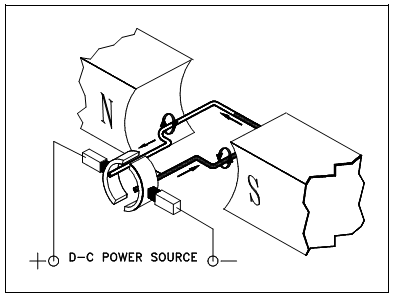Torque
Torque is described as in which force that tends to generates and maintains rotation. The method of torque in a DC motor is to gives the mechanical output or drives the piece of equipment which the DC motor is attached to.
Whenever a voltage is applied to a motor, current will flow by the field winding, developing a magnetic field.Current will also flow by the armature winding, to the positive brush from the negative brush as display in Figure.
Because the armature is a current- carrying conductor within a magnetic field, a conductor has a force exerted on it and tending to move it at right angles to that field. By using the left-hand rule for current- carrying conductors, you will look that the magnetic field on one side is strengthened at the bottom, although it is weakened on the other side.
Figure: Armature Current in a Basic DC Motor
Using the right-hand rule for Motors, we could see in which there is a force exerted on the armature that tends to turn the armature in the counter-clockwise direction. A sum of the forces, in pounds, multiplied through the radius of the armature, in feet, is equivalent to the torque developed through the motor in pound-feet (1b - ft).
It is evident from Figure which if the armature current was reversed, but the field was the similar, torque would be established in the opposite direction. Such as, if the field polarity was reversed and the armature remained the similar, torque would also be established within opposite direction.
The force in which is created on a conductor of a motor armature is due to the combined action of the magnetic fields. A force developed is straightly proportional to the strength of the major field flux and the strength of the field around the armature conductor. Since we known, the field strength around every armature conductor depends on the amount of current flowing by the armature conductor.Thus, the torque that is developed through the motor could be determined by using Equation (6-1).

Equation (6-1).
T = KΦ Ia (6-1)
where
T = torque, lb-ft
K = a constant depending on physical size of motor
Φ= field flux, number of lines of force per pole
Ia = armature current